不定式用法1
- 格式:doc
- 大小:20.50 KB
- 文档页数:2

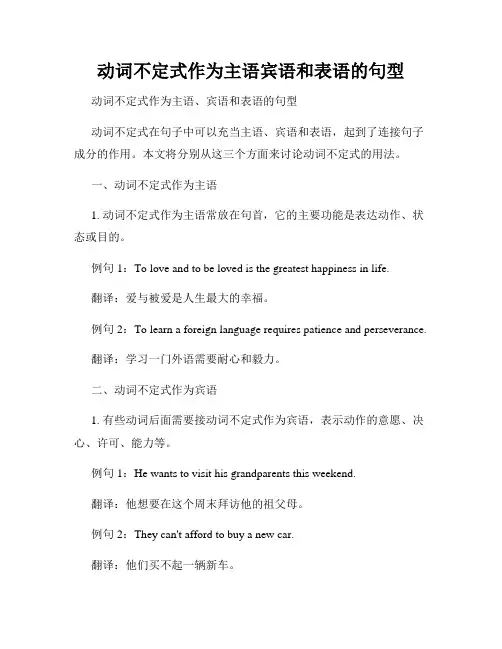
动词不定式作为主语宾语和表语的句型动词不定式作为主语、宾语和表语的句型动词不定式在句子中可以充当主语、宾语和表语,起到了连接句子成分的作用。
本文将分别从这三个方面来讨论动词不定式的用法。
一、动词不定式作为主语1. 动词不定式作为主语常放在句首,它的主要功能是表达动作、状态或目的。
例句1:To love and to be loved is the greatest happiness in life.翻译:爱与被爱是人生最大的幸福。
例句2:To learn a foreign language requires patience and perseverance.翻译:学习一门外语需要耐心和毅力。
二、动词不定式作为宾语1. 有些动词后面需要接动词不定式作为宾语,表示动作的意愿、决心、许可、能力等。
例句1:He wants to visit his grandparents this weekend.翻译:他想要在这个周末拜访他的祖父母。
例句2:They can't afford to buy a new car.翻译:他们买不起一辆新车。
2. 有些动词后面只能接动词不定式作为宾语,不能接动名词。
例句1:She decided to study abroad after graduation.翻译:她决定毕业后去国外留学。
例句2:I promised to help him with his homework.翻译:我答应帮他做作业。
三、动词不定式作为表语1. 动词不定式作为表语和系动词连用,表达主语的状态、特点或能力等。
例句1:Her dream is to become a famous singer.翻译:她的梦想是成为一名著名的歌手。
例句2:My goal is to learn Spanish fluently.翻译:我的目标是流利地学习西班牙语。
2. 有些系动词后面只能接动词不定式作为表语,不能接形容词。
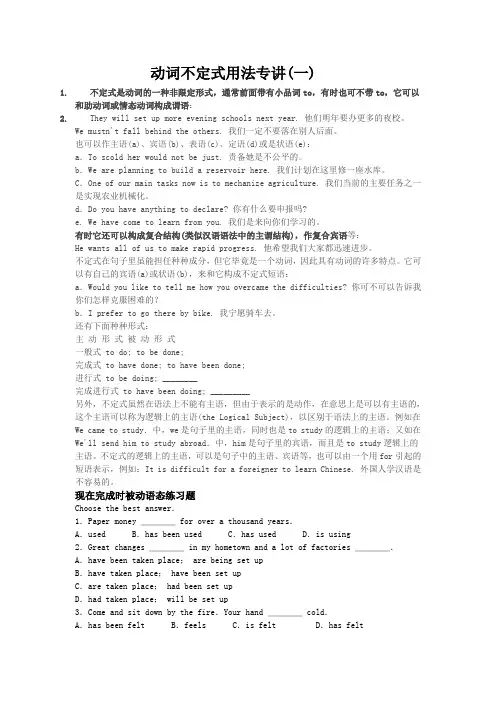
动词不定式用法专讲(一)1.不定式是动词的一种非限定形式,通常前面带有小品词to,有时也可不带to,它可以和助动词或情态动词构成谓语:2.They will set up more evening schools next year. 他们明年要办更多的夜校。
We mustn't fall behind the others. 我们一定不要落在别人后面。
也可以作主语(a)、宾语(b)、表语(c)、定语(d)或是状语(e):a.To scold her would not be just. 责备她是不公平的。
b.We are planning to build a reservoir here. 我们计划在这里修一座水库。
C.One of our main tasks now is to mechanize agriculture. 我们当前的主要任务之一是实现农业机械化。
d.Do you have anything to declare? 你有什么要申报吗?e. We have come to learn from you. 我们是来向你们学习的。
有时它还可以构成复合结构(类似汉语语法中的主谓结构),作复合宾语等:He wants all of us to make rapid progress. 他希望我们大家都迅速进步。
不定式在句子里虽能担任种种成分,但它毕竟是一个动词,因此具有动词的许多特点。
它可以有自己的宾语(a)或状语(b),来和它构成不定式短语:a.Would you like to tell me how you overcame the difficulties? 你可不可以告诉我你们怎样克服困难的?b.I prefer to go there by bike. 我宁愿骑车去。
还有下面种种形式:主动形式被动形式一般式 to do; to be done;完成式 to have done; to have been done;进行式 to be doing; ________完成进行式 to have been doing; _________另外,不定式虽然在语法上不能有主语,但由于表示的是动作,在意思上是可以有主语的,这个主语可以称为逻辑上的主语(the Logical Subject),以区别于语法上的主语。

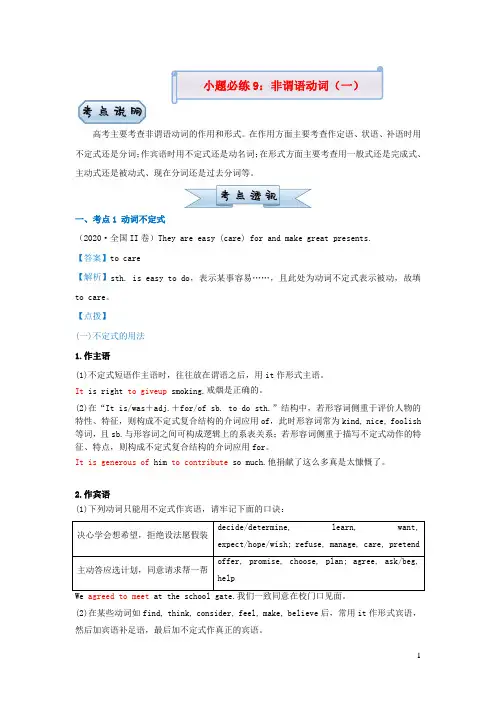
高考主要考查非谓语动词的作用和形式。
在作用方面主要考查作定语、状语、补语时用不定式还是分词;作宾语时用不定式还是动名词;在形式方面主要考查用一般式还是完成式、主动式还是被动式、现在分词还是过去分词等。
一、考点1 动词不定式(2020·全国II 卷)They are easy (care) for and make great presents.【答案】to care【解析】sth. is easy to do ,表示某事容易……,且此处为动词不定式表示被动,故填to care 。
【点拨】(一)不定式的用法1.作主语(1)不定式短语作主语时,往往放在谓语之后,用it 作形式主语。
It is right to giveup smoking.戒烟是正确的。
(2)在“It is/was+adj.+for/of sb. to do sth.”结构中,若形容词侧重于评价人物的特性、特征,则构成不定式复合结构的介词应用of ,此时形容词常为kind, nice, foolish 等词,且sb.与形容词之间可构成逻辑上的系表关系;若形容词侧重于描写不定式动作的特征、特点,则构成不定式复合结构的介词应用for 。
It is generous of him to contribute so much.他捐献了这么多真是太慷慨了。
2.作宾语(1)下列动词只能用不定式作宾语,请牢记下面的口诀:(2)在某些动词如find, think, consider, feel, make, believe 后,常用it 作形式宾语,然后加宾语补足语,最后加不定式作真正的宾语。
We think it our duty to protect the environment.我们认为保护环境是我们的责任。
3.作表语不定式作表语多表示某一次具体的、特定的或有待实现的动作。
My dream is to enter Peking University.我的梦想是考入北京大学。

动词不定式用法动词不定式在中学英语中应用非常广泛,一方面在句中可起名词、形容词或副词的作用,同时也可在句中作主语、宾语、定语、状语和宾语补足语。
动词不定式的形式一般是to +动词原形,但to有时要省去。
而动词不定式在具体运用时用不用to,取决于谓语动词的用法。
现就以下几方面介绍如下。
一、不定式结构1. 带to的不定式结构能直接跟带to的不定式结构的动词主要有:want, ask, tell, hope, learn, try, decide, forget, remember, like, love, stop, go, come等。
如:I want to go to the movies with you.我想跟你一起去看电影。
Don’t forget to turn off the light before you leave.在你离开之前别忘了关灯。
注意:动词不定式的否定形式是在不定式前直接加not,即not to do sth.。
如:Dave told me not to wake up Kate.大卫告诉我别叫醒凯特。
2. 不带to的不定式结构以下几种情况使用不带to的动词不定式:(1)在固定词组had better之后。
注意:had better的否定形式是had better not do sth.。
如:You had better go home now.你最好现在回家。
It’s cold outside. You’d better not go out.外面很冷,你最好不要出去。
(2)在let, make, see, feel, watch, hear等感官或使役动词后,要跟不带to的动词不定式作宾语补足语。
如:I made them give me the money back.我迫使他们把钱还给我。
I didn’t see you come in.我没看见你进来。
(3)在引导疑问句的why not之后。
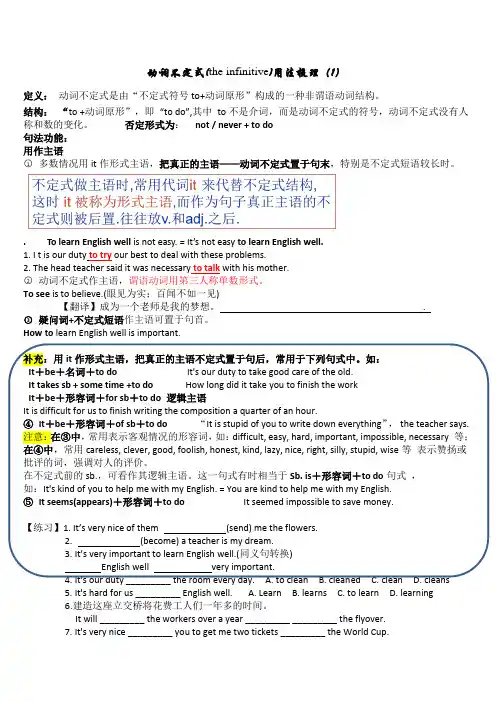
动词不定式(the infinitive)用法梳理(1)定义:动词不定式是由“不定式符号to+动词原形”构成的一种非谓语动词结构。
结构:“to +动词原形”,即“to do”,其中to不是介词,而是动词不定式的符号,动词不定式没有人称和数的变化。
否定形式为:not / never + to do句法功能:用作主语○1多数情况用it作形式主语,把真正的主语——动词不定式置于句末,特别是不定式短语较长时。
. To learn English well is not easy. = It’s not easy to learn English well.1. I t is our duty to try our best to deal with these problems.2. The head teacher said it was necessary to talk with his mother.○2动词不定式作主语,谓语动词用第三人称单数形式。
To see is to believe.(眼见为实;百闻不如一见)【翻译】成为一个老师是我的梦想。
.○3疑问词+不定式短语作主语可置于句首。
How to learn English well is important.补充:用it作形式主语,把真正的主语不定式置于句后,常用于下列句式中。
如:It+be+名词+to do It's our duty to take good care of the old.It takes sb + some time +to do How long did it take you to finish the workIt+be+形容词+for sb+to do 逻辑主语It is difficult for us to finish writing the composition a quarter of an hour.④It+be+形容词+of sb+to do “It is stupid of you to write down everything”,the teacher says. 注意:在③中,常用表示客观情况的形容词,如:difficult, easy, hard, important, impossible, necessary 等;在④中,常用careless, clever, good, foolish, honest, kind, lazy, nice, right, silly, stupid, wise等表示赞扬或批评的词,强调对人的评价。
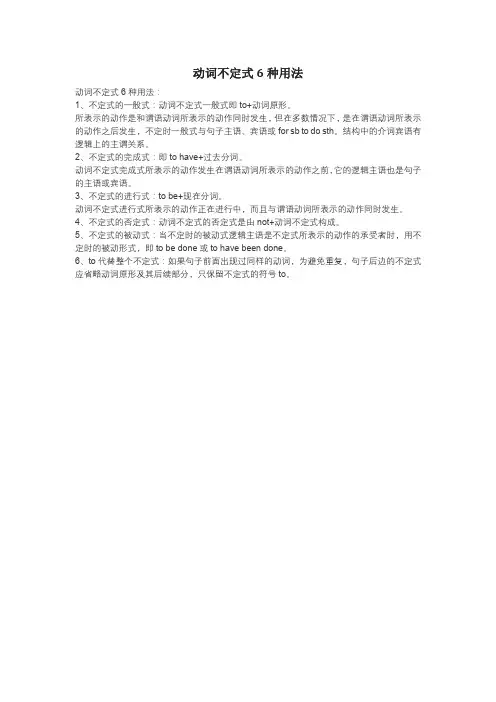
动词不定式6种用法
动词不定式6种用法:
1、不定式的一般式:动词不定式一般式即to+动词原形。
所表示的动作是和谓语动词所表示的动作同时发生,但在多数情况下,是在谓语动词所表示的动作之后发生,不定时一般式与句子主语、宾语或for sb to do sth。
结构中的介词宾语有逻辑上的主谓关系。
2、不定式的完成式:即to have+过去分词。
动词不定式完成式所表示的动作发生在谓语动词所表示的动作之前,它的逻辑主语也是句子的主语或宾语。
3、不定式的进行式:to be+现在分词。
动词不定式进行式所表示的动作正在进行中,而且与谓语动词所表示的动作同时发生。
4、不定式的否定式:动词不定式的否定式是由not+动词不定式构成。
5、不定式的被动式:当不定时的被动式逻辑主语是不定式所表示的动作的承受者时,用不定时的被动形式,即to be done或to have been done。
6、to代替整个不定式:如果句子前面出现过同样的动词,为避免重复,句子后边的不定式应省略动词原形及其后续部分,只保留不定式的符号to。
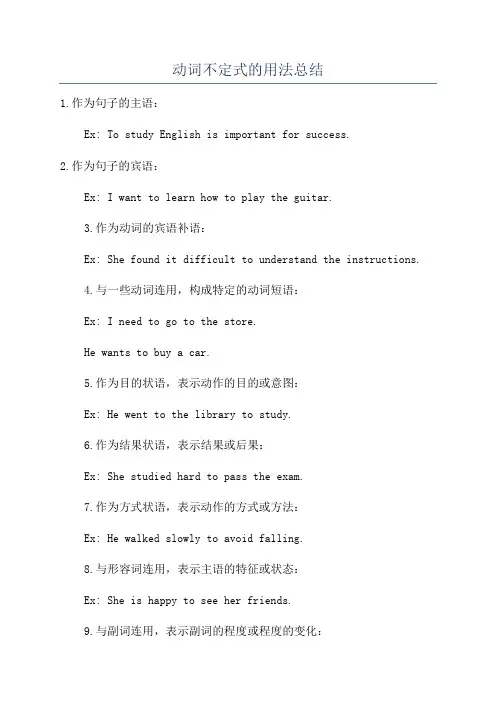
动词不定式的用法总结
1.作为句子的主语:
Ex: To study English is important for success.
2.作为句子的宾语:
Ex: I want to learn how to play the guitar.
3.作为动词的宾语补语:
Ex: She found it difficult to understand the instructions.
4.与一些动词连用,构成特定的动词短语:
Ex: I need to go to the store.
He wants to buy a car.
5.作为目的状语,表示动作的目的或意图:
Ex: He went to the library to study.
6.作为结果状语,表示结果或后果:
Ex: She studied hard to pass the exam.
7.作为方式状语,表示动作的方式或方法:
Ex: He walked slowly to avoid falling.
8.与形容词连用,表示主语的特征或状态:
Ex: She is happy to see her friends.
9.与副词连用,表示副词的程度或程度的变化:
Ex: He tried to be more careful.。
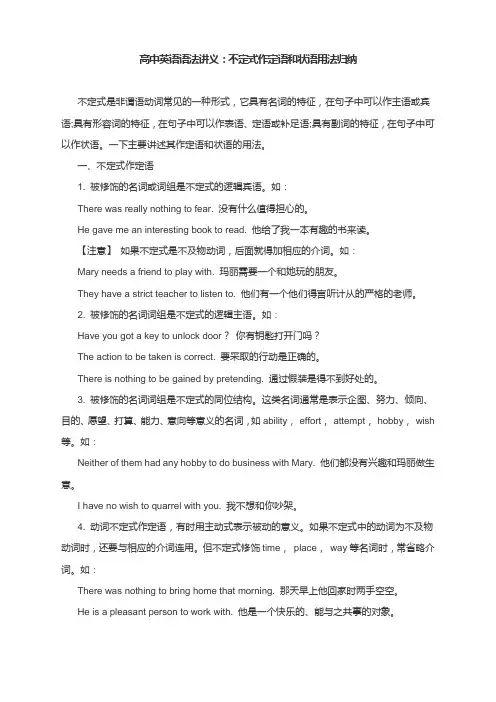
高中英语语法讲义:不定式作定语和状语用法归纳不定式是非谓语动词常见的一种形式,它具有名词的特征,在句子中可以作主语或宾语;具有形容词的特征,在句子中可以作表语、定语或补足语;具有副词的特征,在句子中可以作状语。
一下主要讲述其作定语和状语的用法。
一、不定式作定语1. 被修饰的名词或词组是不定式的逻辑宾语。
如:There was really nothing to fear. 没有什么值得担心的。
He gave me an interesting book to read. 他给了我一本有趣的书来读。
【注意】如果不定式是不及物动词,后面就得加相应的介词。
如:Mary needs a friend to play with. 玛丽需要一个和她玩的朋友。
They have a strict teacher to listen to. 他们有一个他们得言听计从的严格的老师。
2. 被修饰的名词词组是不定式的逻辑主语。
如:Have you got a key to unlock door?你有钥匙打开门吗?The action to be taken is correct. 要采取的行动是正确的。
There is nothing to be gained by pretending. 通过假装是得不到好处的。
3. 被修饰的名词词组是不定式的同位结构。
这类名词通常是表示企图、努力、倾向、目的、愿望、打算、能力、意向等意义的名词,如ability,effort,attempt,hobby,wish 等。
如:Neither of them had any hobby to do business with Mary. 他们都没有兴趣和玛丽做生意。
I have no wish to quarrel with you. 我不想和你吵架。
4. 动词不定式作定语,有时用主动式表示被动的意义。
如果不定式中的动词为不及物动词时,还要与相应的介词连用。
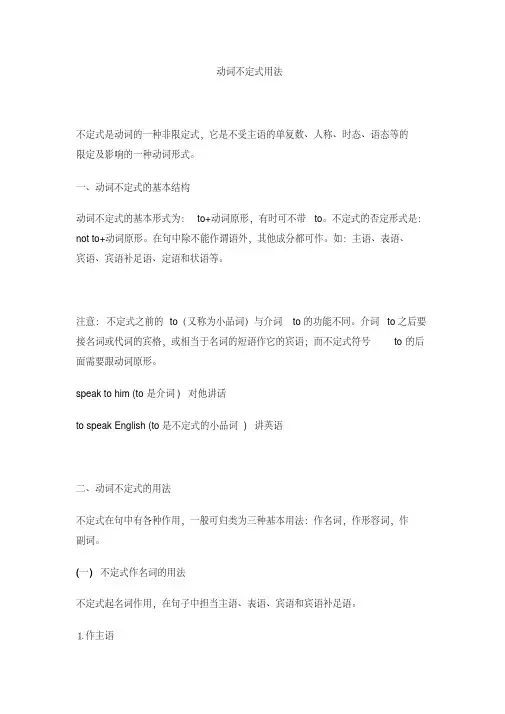
动词不定式用法不定式是动词的一种非限定式,它是不受主语的单复数、人称、时态、语态等的限定及影响的一种动词形式。
一、动词不定式的基本结构动词不定式的基本形式为:to+动词原形,有时可不带to。
不定式的否定形式是:not to+动词原形。
在句中除不能作谓语外,其他成分都可作。
如:主语、表语、宾语、宾语补足语、定语和状语等。
注意:不定式之前的to(又称为小品词)与介词to的功能不同。
介词to之后要接名词或代词的宾格,或相当于名词的短语作它的宾语;而不定式符号to的后面需要跟动词原形。
speak to him (to 是介词) 对他讲话to speak English (to 是不定式的小品词) 讲英语二、动词不定式的用法不定式在句中有各种作用,一般可归类为三种基本用法:作名词,作形容词,作副词。
(一) 不定式作名词的用法不定式起名词作用,在句子中担当主语、表语、宾语和宾语补足语。
⒈作主语名词用法的不定式和名词一样,可担任句子的主语。
To grow more trees here is very important.(=It is very important to grow more trees here.) 在这里多种些树是非常重要的。
To hear your voice is so nice.(=It is so nice to hear your voice.) 听到你的声音真高兴。
To speak English well is not easy for me.(=It is not easy for me to speak English.) 把英语说好对我来说并不容易。
To walk to school takes me twenty minutes.(=It takes me twenty minutes to walk to school.) 步行到学校我要花20分钟。
的句型中,it是形式主语,真正的主语是不定式;使用这种注意:在It is… to…”结构,可以避免句子的头重脚轻。
动词不定式用法小结[1]3概要动词不定式用法小结动词不定式是一种非谓语动词形式,其结构为“to+动词原形”,其中to不是介词,而是动词不定式的符号,称为小品词,动词不定式没有人称和数的变化。
动词不定式和其后面的名词等构成不定式短语,在句子中可以用作主语、表语、宾语、补足语、定语、状语等。
一. 作主语例如:To be a doctor is hard.做医生很难。
To learn English well is not easy.学好英语不容易。
动词不定式(短语)作主语时,为了避免句子的头重脚轻,可以用“it”作形式主语,而把真正的主语--动词不定式(短语)放在句子的后部。
例如上面的句子可以表示为:It is hard to be a doctor.It is not easy to learn English well. 再如:It’s important to plant trees in spring.如果动词不定式的动作是谁做的,可以在动词不定式前面加一个由介词for 引导的短语,称为不定式的复合结构。
例:It’s good for us to read English aloud in the morning.对我们来说每天早晨大声读英语是很有益的。
It is important for students to use English every day.对学生来说每天使用英语是很重要的。
总结:it is +adj for sb to do sth.二. 作表语:动词不定式(短语)作表语常用于系词be的后面。
例:His work is to drive a car.他的工作是开车。
My job is to feed animals.我的工作是饲养动物。
Her ambition is to be a doctor.她的理想是当医生。
三. 作宾语动词不定式(短语)可以放在一些动词后面用作宾语,能以动词不定式作宾语的动词有:begin,start, want, forget, remember, show, learn, like, hate, love, ask 等。
不定式作定语3种情况不定式作定语情况:1、被修饰成分在意义上是动词不定式表示的动作的执行者时,作定语用的动词不定式的动词可以是不及物动词,如果是及物动词,动词要带宾语。
2、被修饰成分在意义上是动词不定式表示的动作的承受者时,作定语用的动词不定式的动词应是及物动词,如果是不及物动词,其后必须补加相应的介词。
3、被修饰成分在意义上既不是动词不定式所表示的动作的执行者,也不是动词不定式表示的动作的承受者时,作定语用的动词不定式(短语)比较灵活,既可以是不及物动词,也可以是及物动词加宾语构成的动词短语。
定语的用法1、单词作定语考点1)形容词性物主代词作定语。
如:my bag,her friends. 2)名词作定语。
名词单数作定语。
如:an apple tree,some apple trees. 3)名词复数所有格作定语。
如:a two days’holidays= a two-day holiday= a holiday of two days. 4)表性别时随着被修饰词的单复数改变而改变。
如:a woman teacher,some women teachers.特别提醒:clothes, sport 做定语的时候,必须用复数形式。
比如:sports meeting, sports news, sports shoes, clothes shop等。
2、介词短语作定语考点重点考of,with,in以及方位介词引导的介词短语。
例如:the importance of learning English学习英语的重要性;the tea with milk加奶的茶;the man in blue穿蓝色衣服的男人;the map on the wall 墙上的地图等。
3、动词作定语考点动词作定语主要考不定式,现在分词,过去分词,考点如下:1)不定式作定语,大家要记住三种情况。
一个是放在被不定代词或被the first/next/only/last等修饰名词后面。
不定式作定语3种情况例句(1)定语从句引导的不定式:例句:他是一位博学多闻的人,擅长于探索未知的东西。
(2)用于表语的不定式:例句:他的主要任务就是保证和调和良好的关系。
(3)作定语的不定式:例句:他在志愿者活动中,尽了最大的努力去帮助那些需要帮助的人。
不定式作定语是指动词不定式修饰名词、代词、副词或整个主句,代替一个表示某种属性或特征的形容词。
它常用在形容词短语或介词短语之后,强调句子成分的作用。
下面就来看看不定式作定语的具体用法。
一、定语从句引导的不定式相比较于定语从句引导的动词,定语从句引导的不定式可以代表一系列动作,而不仅仅是表示一个抽象想法。
它可以放在形容词性物主代词之后,用以修饰这个物主代词,以突出它的某些特征。
此外,它还可以用来修饰名词,强调定甴自身的某些能力或职责。
例如:1)He is a man of great learning and skill in exploring things unknown.他是一位博学多闻的人,擅长于探索未知的东西。
2)Her chief task is that of keeping and maintaining good relations. 她的主要任务就是保证和调和良好的关系。
二、用于表语的不定式不定式作表语的用法也很普遍,它表示句子的主语所具有的责任、义务或动作。
例如:1)His duty is to enforce the law. 他的职责是执行法律。
2)His job was to build bridges. 他的任务是建造桥梁。
三、作定语的不定式作定语的不定式经常出现在一些表示能力或能耐的名词后,表达的是句子的主语的能力。
例如:1)He has a talent for singing. 他有歌唱的才能。
2)He is a man of great strength. 他拥有强壮的体魄。
3)He devoted himself to helping those in need in his voluntary activities. 他在志愿者活动中,尽了最大的努力去帮助那些需要帮助的人。
动词不定式的用法初中语法规则动词不定式是指不带主语,含有不定式符号“to”的动词形式。
在英语语法中,动词不定式有着重要的用法和作用。
本文将介绍初中语法规则中关于动词不定式的用法。
一、作主语:动词不定式可以作为句子的主语,常常出现在句子的开头。
例如:To learn a foreign language is beneficial for young students.学一门外语对年轻学生来说是有益的。
二、作宾语:动词不定式可以作为及物动词的宾语。
例如:I want to visit my grandparents next week.我下周想去探望我的祖父母。
三、作介词的宾语:某些介词后面必须使用动词不定式作宾语,在不定式前加适当的介词。
例如:I am good at playing the piano.我擅长弹钢琴。
四、作定语:动词不定式可以作为名词前的定语来修饰名词。
例如:It's important to have a healthy lifestyle.保持健康的生活方式很重要。
五、作补语:某些动词后面可以跟动词不定式作补语。
例如:She made me laugh out loud.她让我笑得很大声。
六、作状语:动词不定式可以作为句子的状语,表示目的、结果、原因、方式等。
例如:He ran fast to catch the bus.他跑得很快,为的是赶上公车。
七、作形容词的补语:动词不定式可以作为形容词的补语,补充说明主语的状态或特征。
例如:I am pleased to meet you.很高兴见到你。
八、作名词的补语:某些名词后面可以跟动词不定式作补语。
例如:It's my dream to become a writer.成为一名作家是我的梦想。
九、作感叹句的主语或补语:动词不定式可以作为感叹句的主语或补语。
例如:To win the competition is so exciting!赢得比赛太令人兴奋了!综上所述,动词不定式在初中语法规则中有着多种重要的用法。
Unit1 动词不定式的用法总结动词不定式由:“to +动词原形”构成,其否定形式是“not to do”。
不定式可以带宾语或状语构成不定式短语,没有人称和数的变化,但有时态和语态的变化。
不定式具有名词特征,可作主语、宾语、状语、表语和定语,但不能单独作谓语。
不定式的用法:作主语。
不定式短语作主语时,往往放在谓语动词后,用it 作形式主语。
To see is to believe.It is possible to live an independent and fulfilling life.(P4)作宾语。
不定式短语作宾语时,如果还带有宾语补足语,往往把不定式宾语放在宾语补足语之后,而用it作形式宾语。
常见的带不定式作宾语的动词,begin, continue, hope, decide, want, wish, try, learn, afford, agree, manage, refuse等等。
He wanted to go.I find it interesting to study English.I have learned to adapt to my disability.(P2)作宾语补足语。
(ask, tell, order, cause, allow, want, like , advise, force, permit, get等)He asked me to do the work with him.注意:在feel, hear, listen to, look at, notice, observe, see, watch, have, let, make 等词后的补足语中,不定式不带to,但是这些句子如果变成被动结构,就必须带to。
I often hear him sing the song.He is often heard to sing the song.She was invited to become the headteacher of the first online school for disabled students.(P4)作定语。
不定式练习
1. Tell him ______ the light.
A. to turn
B. not to turn on
C. to not turn
D. not to turn
2. It took us more than two hours _______ the dinner.
A. prepare
B. preparing
C. to prepare
D. to be prepared
3. We felt the earth _______.
A. move
B. moveing
C. to move
D. be moved
4. The students were made ______ the text ten times.
A. read
B. reading
C. to read
D. to be read
5. The chair looks rather hard _______, but in fact it is very comfortable.
A. to sit
B. to sit on
C. sitting
D. sit
6. Nobody knows __________next.
A. what to do
B. to do what
C. which to do
D. how to do
7. It is very important ______ us ________these words.
A. to, to remember
B. for, to remember
C. for, remember
D. for, remembering
8. _______ English well, one must have a lot practice.
A. For speaking
B. Speaking
C. To speak
D. Speak
9. I'm going to the library ______ the books.
A. return
B. borrow
C. to return
D. to lend
10. We went to town _________ some shopping.
A. doing
B. did
C. to make
D. to do
11. The funny story _______ me laugh. A. make B. making C. to make D. made
12. After the final exam, I think all the students want _________.
A. stop to have a rest
B. to stop having a rest
C. to stop to have a rest
D. stopping to have a rest
13. It is very kind ___ you to help me with my housework. It is hard __me to do all the work.
A. of, for
B. for, of
C. of, to
D. to, for
14. Many people think it very difficult _______ English.
A. to say
B. to learn
C. speak
D. for speaking
15. The teacher asked the students __________ her _______ the word again.
A. listen to; to read
B. to hear; say
C. to listen to; speak
D. to listen to; pronounce
16.Remember ______ the book here tomorrow.
A. bring
B. to bring
C. take
D. to take
17. ---Let's have a rest, shall we?
--- Not now. I don't want to stop _______ the letter yet.
A. write
B. to write
C. writing
D. and write
18. ---This physics problem is too difficult. Can you show me _______, Wang Lin?
--- Sure.
A. what to work it out
B. what to work out it
C. how to work it out
D. how to work out it
19.--- How can I improve my spoken English?
--- You have to practise ______ as much as you can.
A. speak
B. speaking
C. spoken
D. to speak
20. --- How about going hiking this weekend?
--- Sorry. I prefer _______ rather than _______.
A. to stay at home, go out
B. to go out, stay at home
C. staying at home, go out
D. going out, stay at home。